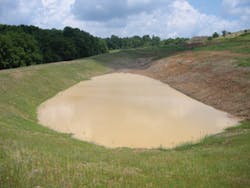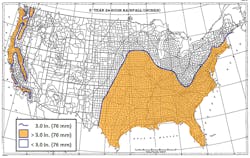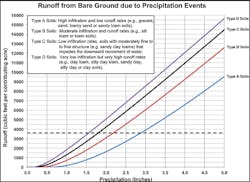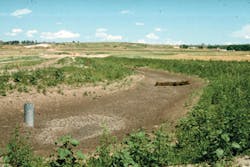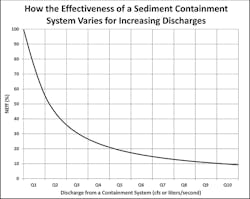Designing Effective Sediment Basins and Traps
The most effective method to remove suspended particles from runoff waters is a properly designed sediment basin and/or trap. When developing a containment system for massive debris flow, it is very important that sufficient containment volume exists. However, for the typical construction-site stormwater pollution prevention plan (SWPPP), volume is not the most important parameter to consider for an effective sediment basin/trap (Fifield 2011).
Without a doubt, such a criterion provides standardization in capturing sediment-laden runoff waters. It is a simple approach for designing a sediment containment system (SCS) and requires little accountability. However, developing effective sediment basins/traps encompasses more technical skills and knowledge than simply ensuring sufficient containment volume exists to capture runoff from disturbed soils. Yet, this one-size-fits-all volume criterion continues to be widely embraced. Why?
EPA’S 1992 Criterion
It appears that the one-size-fits-all criterion for sediment basins/traps came from US EPA when it published the following in the Federal Register (1992, page 41201):
The Agency selected a 3-inch storm event as representative of the 2-year, 24-hour storm, based on the evaluation of the 2-year, 24-hour storm in a number of locations. The Agency further assumed that a 3-inch storm will generate 1 inch of runoff, which is approximately 3,600 cubic feet. (This assumes that one-third of the rainfall runs off the site, and two-thirds of the rainfall is infiltrated at the site). The 3,600 cubic foot criterion has also been identified in EPA Number 841B91109 (EPA 1991) as being able to handle 90% of the storms each year.
In the world of hydrologic jargon, “1 inch of runoff” indicates that if runoff waters were distributed uniformly over a unit area, they would be 1 inch (25 mm) deep. When unit area is expressed in acres, the volume of runoff per unit area is calculated as follows:
VOLRO = 1.0 in. x 1.0 ft. ÷ 12 in. x 43,560 ft.2/ac. = 3,630 ft.3/ac.
which is approximately 3,600 ft.3/ac.
A similar calculation to approximate 250 m3/ha can be completed for 25 mm of runoff when area is expressed in hectares.
While it is a simple concept to standardize containment volume for sediment basins/traps, there are significant flaws with EPA’s 1992 ruling.
First, a 3-inch (76-mm) storm event is not representative of a two-year, 24-hour (i.e., 50% chance of occurrence) frequency rainfall event within the United States. Figure 1 illustrates that most of the nation experiences two-year, 24-hour rainfall events that are less than or greater than 3 inches (76 mm).
Second, the assumption that only 1 inch (25 mm) of runoff will discharge from all soil types when 3 inches (76 mm) of rainfall occur is not realistic.
Hydrologic modeling shows that 3,600 ft.3/ac. (250 m3/ha) of runoff will occur at 2.9-, 2.2-, 1.8-, and 1.6-inch (74-, 56-, 46-, and 41-mm) rainfall events for Type A (sandy), Type B, Type C, and Type D (clay) soils, respectively. Thus, the assumption that 1 inch (25 mm) of runoff is approximated by 3 inches (76 mm) of rainfall would be valid only if the nation’s soils were composed solely of sandy material. Obviously, this is not the case!
Third, a criterion for discharging contained waters does not exist in this ruling. Thus, this criterion gives an impression that EPA is advocating the use of “retention” sediment basins/traps to retain runoff. Yet, go out onto large construction sites, and sediment basins/traps found are usually detention structures.
Fourth, when all inflow waters from construction sites are retained, then a sediment basin/trap is 100% effective in removing suspended particles from runoff. However, Figure 2 shows such idealized conditions cannot happen for all rainfall events and runoff from all soil types. Rainfall events as small as 1.6 inches (41 mm) can cause sediment laden runoff from Type D (clay) soils to discharge from a sediment basins/traps having a volume of 3,600 ft.3/ac. (250 m3/ha).
Fifth, Figure 3 illustrates that when rainfall events are 3 inches (76 mm) or larger, flood discharges of sediment-laden runoff waters from all soil types will occur from sediment basins/traps having containment volumes of only 3,600 ft.3/ac. (250 m3/ha).
EPA’S 1998 to 2008 Criteria
Requiring a minimum of 3,600 ft.3/ac. (250 m3/ha) for sediment basins/traps lulls designers and regulatory agencies into believing containment volume is the most important parameter for developing effective sediment basins/traps. Unfortunately, such a criterion often results in the design and approval of oversized and/or undersized containment systems.
Beginning with its 1998 (Federal Register 1998) and through 2008 (EPA 2008) rulings, it appears EPA tried to address the above problem by requiring that sediment basins/traps are to:
- Have sufficient volume to contain runoff from a local two-year, 24-hour rainfall event, or
- Have a default containment volume of 3,600 ft.3/ac. (250 m3/ha).
On a positive note, these criteria now provide a method to avoid designing and implementing needlessly large sediment basins/traps for rainfall events that are less than 3 inches (76 mm). Consider a two-year, 24-hour rainfall event of 1.25 inches (32 mm) where construction occurs on Type C soils. Figure 2 illustrates that runoff will be about 2,000 ft.3/ac. (140 m3/ha). Thus, the volume of a sediment basin/trap in such an area needs to be only about 56% of the size necessary when using EPA’s default criterion.
Conversely, when rainfall events are greater than 3 inches (76 mm), runoff volumes can become very large depending upon the soil type. Consider a two-year, 24-hour rainfall event of 4 inches (102 mm) falling on bare-ground Type C soils. Figure 2 illustrates a runoff volume of about 12,070 ft.3/ac. (845 m3/ha). Using EPA’s default containment volume of 3,600 ft.3/ac. (250 m3/ha) results in development of a structure that might capture about 30% of the sediment-laden runoff while allowing 70% to discharge from the system (see Figure 3).
Sediment Basins/Traps. If you install a sediment basin, you must comply with the following design requirements:
-
Provide storage for either (1) the calculated volume of runoff from a 2-year, 24-hour storm (see Appendix H), or(2) 3,600 cubic feet per acre drained;
-
When discharging from the sediment basin, utilize outlet structures that withdraw water from the surface in order to minimize the discharge of pollutants, unless infeasible.
What is missing with these criteria is a requirement that the draining of contained runoff waters must occur at very low discharge rates. This is necessary if small (e.g., clay colloidal) suspended particles are to be captured, because sufficient time must exist for deposition of the suspended particles. Only by draining contained waters at a low discharge rate (e.g., using skimmers) will an effective system exist.
Summary of EPA’s Requirements for Sediment Basins/Traps
Information associated with EPA’s numerous rulings on its requirements for sediment basins/traps are summarized below.
- The 1992 ruling assumed a two-year, 24-hour rainfall event of 3.0 inches (76 mm) results in 1.0 inch (25 mm) of runoff from bare ground, which is equivalent to 3,600 ft.3/ac. (250 m3/ha). Such an assumption is valid only for runoff from Type A (sandy) soils.
- The 1998–2008 rulings specified that containment volumes of a sediment basins/traps can be determined by either one of the following methods:
a. Capturing runoff resulting from a two-year, 24-hour rainfall event, or
b. Providing 3,600 ft.3/ac. (250 m3/ha).The fact that the last criterion is based upon the assumption 1.0 inch (25 mm) of runoff discharging from bare-ground sandy soils by a two-year, 24-hour rainfall event of 3.0 inches (76 mm) is omitted from these rulings. - The 2012 ruling specified sediment basins/traps are to:
a. Capture runoff resulting from a two-year, 24-hour rainfall event or provide a containment volume of 3,600 ft.3/ac. (250 m3/ha), and
b. Withdraw water from the containment pond surface. - When sediment basins/traps are designed using 3,600 ft.3/ac. (250 m3/ha) for containment volumes, sediment-laden flood discharges from the structures will begin due to inflow runoff waters when rainfall events are approximately:
• 2.9 inches (74 mm) for Type A (sandy) soils
• 2.2 inches (56 mm) for Type B soils
• 1.8 inches (46 mm) for Type C soils
• 1.6 inches (41 mm) for Type D (clay) soils
The Importance of Discharge Rates in Designing Sediment Basins/Traps
Specifying 3,600 ft.3/ac. (250 m3/ha) containment volume does not account for variability in discharges from different bare-ground soil types by rainfall events. Thus, volume is not a good indicator for determining the effectiveness of sediment basins/traps to remove suspended particles from contained runoff waters. Instead, a better indicator lies with evaluating discharge rates (as well as other variables) from the containment system.
Figure 4 illustrates how discharges from sediment basins/traps impact the effectiveness to capture sediment. Notice that maximum effectiveness is realized for low discharge rates. Skimmers can accomplish this task when they take at least 48 hours to drain the system. However, when sediment-laden waters discharge from a containment system at high flow rates, then effectiveness values become low.
Part 2 of this article, which will be in the July/August 2015 issue of Stormwater, will discuss methods for designing and reviewing effective detention sediment basins/traps using techniques suggested by Fifield (2011). Emphasis will be placed on demonstrating why flow lengths and discharge rates from a sediment basin/trap are the more important parameters to consider when designing these structures.
Specific items on sediment basins/traps that will be discussed include
- design size particle to capture,
- impact of discharge rates from the system,
- importance of flow path lengths within the system,
- impact of flocculants, and
- effectiveness during flood flow conditions.
References
Environmental Protection Agency (EPA). 1991. Proposed Guidance Specifying Management Measures for Sources of Nonpoint Pollution in Coastal Waters. EPA No. 841B91109. Office of Water, Washington DC 20460. May 1991.
EPA. 2008. National Pollutant Discharge Elimination System General Permit for Discharges from Large and Small
Construction Activities. Office of Water, Washington DC 20460. June 2008.
EPA. 2012. National Pollutant Discharge Elimination System General Permit for Discharges from Construction Activities. Office of Water, Washington DC 20460. February 2012.
Federal Register. 1992. Environmental Protection Agency, Final NPDES General Permits for Storm Water Discharges From Construction Sites; Notice. Vol. 57, No. 175. September 1992.
Federal Register. 1998. Reissuance of NPDES General Permits for Storm Water Discharges from Construction Activities; Notice. Vol. 63, No. 31. February 1998.
Fifield, Jerald S. 2011. Designing and Reviewing Effective Sediment and Erosion Control Plans. Third Edition. Forester Media, Santa Barbara, CA.
